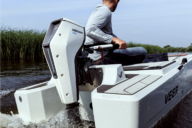In Last week’s Just Cruising column, in the aftermath of the sinking of the Swedish-built Arcona 460 IdaLina 300 miles from the Marquesas Island, we asked readers to comment on bilge pump capacity. Here are several thoughtful responses:
Hi George,
I just read your article on the sinking of IdaLina in French Polynesia. I want to start by saying I have no intention of being an armchair critic of anything they did or didn’t do. I wasn’t there and I’m sure it was a terrifying experience.
To your question of adequate pump capacity I do have an opinion. I believe the way to keep a cruising boat afloat after a significant hull breach offshore is to stem the inflow of water, not to rely on pumps to keep up with whatever that inflow is. It is well established that the minimal bilge pumps installed on most production craft are not intended for dewatering in an emergency. A pillow, towels, plastic bag or tarp, or even a mattress cushion can be used to reduce the amount of water coming into the boat to a sustainable level until repairs can be made.
Captain Antony Dalton
St. Petersburg, FL
Hi George,
We, at Ready4Sea, are of course very sad about what happened to the Arcona 460 IdaLina, not least because some of us also sailed that part of the South Pacific Ocean.
But, I am writing because we are also pretty surprised about some of the discussions going on. There is a lot of talking about spade rudders and aluminum shafts, which are design considerations that obviously have to be taken into account. You are also asking the question about the capacity of pumps. Of course
But, we have not seen anywhere (yet) any discussion about what else could have been done. It’s always difficult to react without being seen as judgmental, and I won’t go down that rabbit hole. It’s always so easy to patronize from ashore, so I hope you will take this reactions for what it is : simply mentioning other ways to handle water ingress situations.
With this said, I’d like to point out that the (very) partial information we have seen over the Internet does not mention anything about trying to plug the hole. It seems to us that every one’s seamanship would go up one notch once we point out that trying to empty the boat of water flowing in is one thing. But it’s even better to stop the water from gushing in. Easier said than done, agreed. But what about plugging the allegedly 15 cm wide hole with a large piece of canvas, or anything that will fit in there snugly?
Sure, it means diving over the side, but this does buy some time. Then, sailors of olden days would also use a sail or similar piece of canvas, stretching it under the hull as tight as possible to blind the leak. Perhaps by doing both the water flow would have slowed enough for the pumps to work? Maybe they tried, maybe it failed, I don’t know. But we feel that these stopgaps should at least be mentioned to the public so that others may prepare and attempt those solutions in future situations.
Safe seas,
Nicolas Remy
Hello George,
From the description here it is hard to assess if larger pumps would have saved the day. If the boat went down in a few minutes, I doubt it.
In my experience, the pumps don’t save the boat, they just buy you time. I have several thoughts on what I would likely have used in this situation. None of these are expensive either.
Like so many other mitigation techniques on a sailboat, we keep a layered approach to this:
1) Collision mat, a triangular mat -with suitable length ropes at each corner- that can be passed under your hull until it covers the holed area. Then tie that off to toe rails or stanchions. This works best with 2-3 people so it can be done quickly. You could also use a small sail like a riding sail or a staysail.
2) Potatoes and plumbers putty. Easy to shape for small-medium sized holes.
3) cushions and pillows. A friend of mine ran a salvage business on the St Lawrence River. When the big bulk carrier ships would run onto the rocks (not an uncommon occurrence in the twisty channels with boiling current) he would place mattresses in the holes and secure them by fastening plywood to the hull. Cushions and pillows would work much the same on a sailboat and also fill large holes quickly to slow water ingress when there is very little time to save the boat.
4) techniques 1-3 may slow or stop the water, but are not permanent for continuing on which you may be forced to do when far from shore. We carry pieces of teak, starboard and plywood that can be cut, epoxied and screwed into place from the inside.
5) a hatchet and cats paw pry-bar to remove cabinetry or flooring to get better access to the source of the flooding. I hope to never have to use this on our fine teak interior.
6) a high water bilge alarm since not all catastrophic leaks are immediately noticeable from the helm and seconds count.
7) practice with the collision mat and putty at the dock every year or so to stay nimble. Calm and quick are the key parameters for addressing major boat leaks. Also practice accessing, closing and opening all seacocks a couple of times a year to ensure you know where they are and that they still work.
Fair Seas,
Todd. Smith
Hi George!
I wanted to quickly comment on your article about the pump capacity and the sinking of the Swedish Arcona IdaLina.
While high-capacity pumps and backup capacity have a value, I simply don’t agree with the assumption that they alone are a good solution. With almost any sailboat, it is relatively easy to add bulkheads that limit the spread of the water in the boat. A fully watertight bulkhead is of course the best but even a bulkhead that allows cables and lines to pass under deck would have contained the water in IdaLina in the aft section of the boat and allowed her to continue to Marquesas assuming they had a backup steering mechanism…
Best Regards,
Martin Holmgren
Hi George,
A quick thought on big holes in boats. Yes, fire up the biggest pump you have. But carrying around a giant pump for a 1 in 100,000 incident is not efficient for a lot of cruising boats. After assigning the mayday and a separate bucket person, my next thought is to stem the flow.
Put a sail over the side. Maneuver it with a line to each corner. I haven’t had to do it but I understand that this can more than halve the flow, quickly. And there are all kinds of the other methods, most require some pre-thought.
They have that goofy nerf cone that can be jammed into a hole. Seems like a Nerf football would work and you can play with it on beaches when you are not sinking .
The toilet installer’s wax ring is well reputed. I used to bring it on deliveries as it packs tight jammed in a ziplock. Mix it with small line or use it as a sealer with whatever you are plugging the hole with.
A cutting board and an expandable boathook, jam the board against the leak and expand the boathook across to a bulkhead.
Your goal is to create time to enable longer term fixes and if necessary … time for another boat to arrive.
Captain Woody Henderson
Hello George,
I felt like adding my two cents worth on this topic, as its not often talked about as a very effective method to get rid of water while attempting a fix.
On my 37ft S&S cruising boat, I fitted a pulley onto the main engine drive shaft, with an over center arm /lever to a belt driven swimming pool pump…….could be any high capacity trash pump even, mounted nearby. The benefit is, you can use the most powerful energy source in the boat, the main engine, supplied by usually a large source of fuel to run it. This could easily pump vast amounts of water for hours with no problem.
I have had some very scary moments before fitting this system, of under size electric bilge pumps, often getting easily jammed with like pieces of plastic in the bilge, just way too little capacity to keep pace with even a few centimeter size hole.
I operated charter catamarans for years in the BVI, and was always amazed at the powers that be, installing basic bilge pumps in a boat costing over a million dollars !! No logic at all.
Regards
Alan Gold












